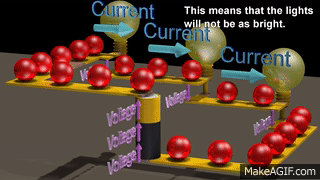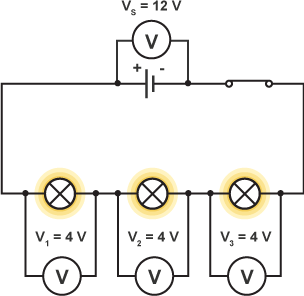Akoranga 11 Mahi Tuatahi 🔗
Take 10 minutes to continue working on the Education Perfect conductors and insulators task + making notes.
Any of the task left unfinished should be completed as homework.
Ngā Whāinga Ako 🔗
- Describe electric current in terms of a moving flow of charge (Coulombs per second)
- Describe voltage in terms of the amount of electrical energy carried by each Coulomb of charge
Write the date and ngā whāinga ako in your book
Charge, Current and Voltage 🔗
- We are moving on from thinking about static electricity, to thinking about electricity that flows: current electricity.
- Split part of your page into three columns:
- Current, Voltage, and Resistance

Current ($I$) 🔗
- In current electricity, charges have to flow through a conductor (e.g. copper wire).
- The charges that flow are electrons.
- These electrons carry a negative charge, and move from the negative to the positive terminal of the power supply.

🔗

- Current is given the letter $I$ in equations, as it was historically known as intensité du courant (French).
- It is measured in a unit called Amperes (Amps) or A for short.
- It is measured by a ammeter which is placed in series in a circuit.
Pātai Tahi (Q1) 🔗
Discuss with the person next to you, why is it that negative charges flow, and positive charges do not? Write your conclusion down in your book.

Whakatika 🔗

- Electrons carry negative charge, and protons carry positive charge.
- In conductors, electrons are loosely held and can move freely throughout a solid in a “sea” of electrons.
- Protons cannot move, because they reside in the nucleus of the atom, and atoms are fixed in place.
- Electrons cannot flow easily or at all in insulators - this is why you stand on a chair with the Van der Graaf generator.
Charge ($Q$) 🔗
- Each electron carries some amount of charge
- This charge is given the letter $Q$
- Charge is measured in a unit called a $Coulomb$ (C).

Voltage ($V$) 🔗
- At the negative terminal of a power supply, there are a large number of electrons present.
- Because they all have the same charge, they repel each other.
- This “pressure” to get away from each other is called Voltage
- As electrons pass through different components (bulb, resistor etc.) the voltage decreases.
- Components with a higher voltage are brighter/warmer
- The total voltage of the power supply must be “consumed”.

Pātai Rua (Q2): Calculate the Missing Voltage 🔗
Draw these diagrams into your book and label the missing voltages.

Ngohe/Task 🔗
- Collect your sheet from the front
- Cut out the pieces and the middle rectangle
- Glue the big rectangle into your book
- Match up the symbols next to the definitions and glue them in!
- Place all un-crumpled excess paper into the green recycling bin!

Tūhura/Investigation: Current 🔗
- In groups of 3-4 collect a light kit from the trolley and find a station around the room
- Create a circuit with the power supply, two bulbs, and a switch in series.
- Turn your circuit off, add an ammeter in series. Check with your teacher before you turn it back on!
- What does the ammeter measure?
- How does the reading change when you have 1 or 2 bulbs in the circuit?
- How does changing the voltage impact your circuit?

Tūhura/Investigation: John Travoltage 🔗

- Open the PhET Simulation on Google Classroom
- Describe & explain what happens when you move his foot across the mat multiple times.
- Describe & explain what happens when you bring his hand close to the door handle.
- Investigate to see if there is a relationship between the amount of charge needed to cause a spark, and the distance of the hand to the door handle.
